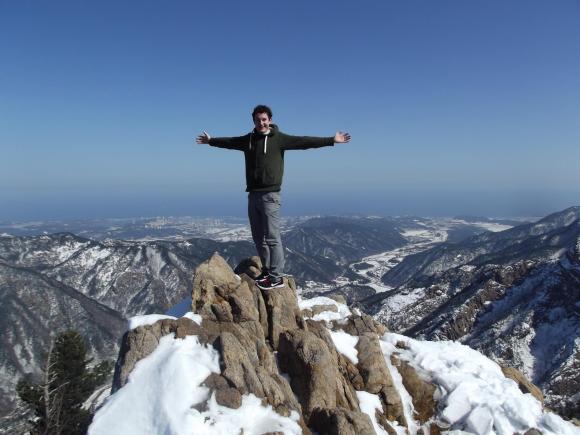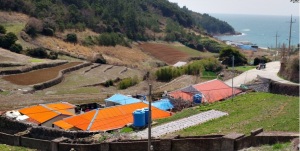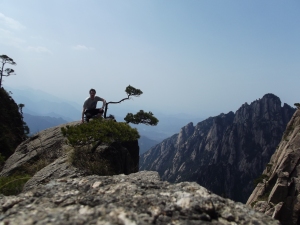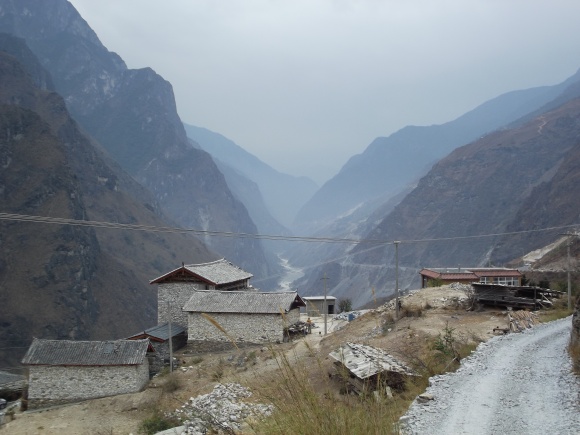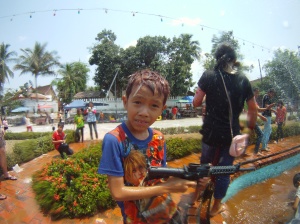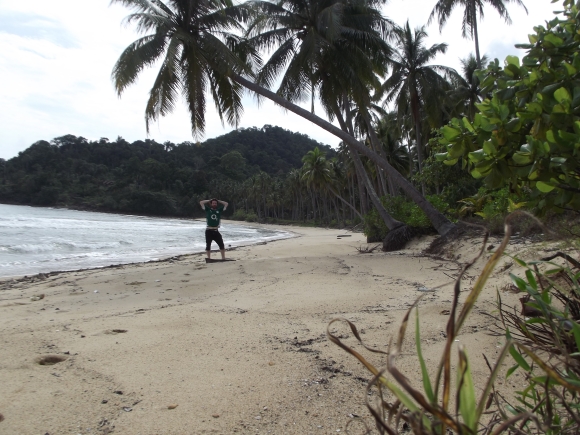So I eventually made it to Bangkok, after 2 months wandering from the chilly shores of Northeastern China to the tropical jungles of Eastern Thailand through the Yangtze River plains of Anhui and Jiangxi provinces, then the foothills of the Hengduan mountains in Yunnan, followed by three weeks spent along the Mekong river and its tributaries in Laos and a final week on an island in the Gulf of Thailand.
Actually, I started long before that. I finished work in Korea on the 27th February amid around 2 weeks of farewell dinners and lunches with colleagues, friends and students. The next day I went on a quick three day roadtrip with Dahye and Sunjin to Gangneung for raw fish and karaoke, the DMZ to hear the armies shouting and look at the barbed wire beaches and Seorak Mountain to get vertigo on a freezing, clear day.
Between then and St. Patrick’s Day I took my bike out on the roads along the Southern edge of the Korean peninsula, finally being able to do them in my own time, without the constraints of a school calendar to draw me away. It was warmer down there also – a big pulling point. I skirted the Southern coast from Busan to Geoje to Namhae to Yeosu, passing through dying fishing villages full of old people sticking to the old ways. I had a policy of having a midday nap at 12 on the nearest beach, and stayed at Jjimjilbang every night, to rest my muscles.
After three days cycling I took a boat to Geumodo – a remote island off the Southern coast of Korea, of interest to me because it was the set of the brilliant Korean horror movie ‘Bedevilled’ (김복남 살인사건의 전말). I spent the day walking a circle route around the idyllic place. Most of the farming out there was still being done by hand and oxen, and the population was old, very old.
Walking through some of the tiny communities, I was reminded of the ‘Bedevilled’ movie, in which a girl returns to the island of her birth after years spent away in Seoul. Her former neighbours are now suspicious and cautious around her, and she begins to notice some strange changes in the atmosphere of the place. I did get some strange looks that day, but i’ll put it down to the sight of a white man ambling along the paths at the bottom of their fields. That would freak me out, too.
Fast forward 10 days and I’m on my last weekend in Korea, visiting the DMZ.
There is only one place where you can visit the ‘demarcation line’ of the DMZ proper, and that’s at Panmunjeom, the only place on the peninsula where South Korean soldiers literally stand face to face with their North Korean counterparts. I was lucky to be visiting the week before Barack Obama himself was due to fly in, and preparations were underway; the South Koreans installing bullet-proof plastic for his 10m walk to the conference room on the line, and the North Koreans watching them every step of the way (standing only 20m away).
We started our standard tour of the conference room (the blue cabin to the left of the photo below) but in mid-talk were suddenly ushered out, our guide hastily padlocking the door behind us. We were herded back up the steps just in time to see some North Korean generals come out of the North Korean building, 20m away, preceded by goose-stepping soldiers. Our guide – Patrick, an Irish-American soldier with tattooes to prove it – muttered “watch these guys step over the line” and indeed they did. 3 of the Nordies turned into the alleyway between the two buildings and stepped up ON to the concrete boundary between the two Koreas. Doing this, they were liable to get shot. But Patrick re-assured us later that they do this quite often, just to rile up the South Koreans, who indeed did get tetchy; moving into battle stance (all the South Korean army in Panmunjeom are over 6’3″ and are the country’s best experts at martial arts). It was a surreal moment, one I’ll never forget. After all that, the North Korean generals took a quick poke around the conference room we had just left and ambled back to their own building, stopping for a moment to point and laugh at us and take photos with old Kodak reel cameras from the 80s.

Left: The view North from Panmunjeom. The blue buildings are shared ‘conference rooms’, built half in North Korea, and half in the South. The far building is in North Korea, with the generals appearing. The closer guards are South Korean, and the far guards are the North Koreans who had just stepped on the demarcation line. Right: pointing at us, the imperialists.
And then, after a suitably debaucherous St. Patrick’s Day with good friends, followed by a quick jaunt across the Yellow Sea to Northeast China and a 22 hour train journey South, I found myself in Anhui province, 500km Southwest of Shanghai, and itching to get back on the bike.
Southern Anhui / Northern Jiangxi provinces was where a lot of rich merchants were exiled to during the Ming dynasty (1368 to 1644). They came with all their wealth, and set up a feudal system – using the locals as their serfs – a system that effectively still exists. They built beautiful merchant villages and towns among the valleys and plains that I cycled through, the buildings all built to allow water to flow through during times of flood, when the families and servants would just migrate to the upper floors. Each village had a pond (Chinese love looking at water) usually situated in a beautiful courtyard where the old women would come to wash clothes at dawn and the old men would come to play chess at dusk.
In Honchuen, on the second night, I turned up to my hostel to find they were having a family party. My host apologized profusely for not having a bed free, but insisted I stay, and offered me a tent in the courtyard beside the pet monkey’s pen. I stayed for 3 days. Nayxier – the man running the hostel – had been an electrician in Shanghai for 15 years, but got sick of the city life, saved up $30,000 in 10 years, and bought an old decaying merchant family’s mansion in Honchuen to refurbish with the money.
I earned my keep by helping him lug wood in from the road to the courtyard, where his craftsmen were cutting them into shape to replace the old rafters of the mansion. In the evenings I gave his 9 year old daughter English lessons. I was fascinated by the way the old mansion was built, with intricate carvings in every nook and cranny and little solars for old people to rest in. I’d love to see how it looks in 5 years.
After the success of that trip I rented the bike out again for another 3 days and struck out for Jiangxi province – 150km to the south over a small range of hills. There, I found more stunning villages and riverside ports, although unfortunately the tour groups had found a lot of them. Then on my last day in Tunxi I climbed Huangshan (Yellow Mountain), one of the holiest mountains in China.
It was a bit of a farce. It cost $40 to climb, and was swarmed with hordes apon hordes of screeching Chinese tour groups. My first experience of mass-tourism in China was a bad one. I was almost knocked off the path at times by convoys of older tour groups going up the mountain on the backs of porters, and was constantly harraunged for photos with giggling teenage girls on school trips (“huallo, pickature ok?”). At the top I could barely find a place to get a good view, and ended up almost killing myself by falling off a cliff trying to find a peaceful spot (OK, I was also trying to take an artsy photo). Eventually I gave up and ran down the mountain, tail between my legs.
Next was a 36 hour train journey (eat, read, sleep, repeat) followed by a 12 hour sleeper bus (full of chinese college kids playing out of tune guitars) and a 7 hour minibus ride (where my neighbour spent a good 4 getting sick into her shopping bag of groceries) to Shangri-La!
After the debacle of Huangshan, I wanted to have some time to myself – sans tour groups – and really off the beaten track. So, having done extensive research almost exclusively on google maps (NEVER plan a trip based solely on google maps, by the way) I set off on another rented mountain bike from Shangri-la – a picturesque frontier town up in the mountains between Burma, Tibet, Sichuan and Yunnan provinces. The name is actually a Chinese government fabrication – they changed the name from Zhongdian in 2001 – and the ‘old town’ has actually all been built in the past 10 years. It’s all built in Tibetan style, a beautiful style of architecture that meshes logs together to maximize their strength against the ripping winds up there.
From Shangri-la it was a very tough 2 day cycle to Tiger Leaping Gorge. In my amateur research I had figured that the drop in altitude from 3,200m at Shangri-la to 1,900m at Tiger Leaping Gorge could only mean a chuckle-worthy freewheeling descent with stops only to take photos and have picnics beside mountain streams. Couldn’t have been more wrong. What I didn’t realize was that to reach Tiger Leaping Gorge, the road needs to cross 5 river valleys first, and when you cross a river valley in Tibet it means falling a luxurious 500m in altitude before grinding the gears to make up the distance on the far side. Absolutely exhausting, mentally and physically. Thank God for the old lady in the guesthouse in Baishuitai, the halfway point, who cooked me up the best noodles i’ve ever eaten for breakfast on the second day. Noodles, bananas, water and snickers. That’s how I got through it.
Anyway, it was all worth it in the end. Tiger Leaping Gorge was stunning. Coming in from the bottom down a 30km (yes, that’s right… 30km) straight descent, I nearly fell off the road when I spotted the gorge opening up below. It’s the deepest gorge in the world; a full 2km almost vertical drop from the top of the mountains to the Yangtze river far, far below. Legend has it that it’s so narrow that a tiger hopped it back in the day and blah blah blah, but really it was quite a sight. I stayed for 2 days.
After another very enjoyable week in the outer regions of China, it was time to go to Laos.
The 24 hour bus journey from Kunming to Luang Prabang was the most fun of the trip so far. The bus driver was – granted – crazy, but he stopped every 4 hours for a bite to eat, and dragged all the occupants of the bus with him. We had a couple of hours kip at the border before it opened and then lumbered into Laos. It was the most marked change in landscape i’ve come across. Laos – in contrast to China – didn’t have any grey buildings to form its village streets. Everything was built from bamboo. Kids were walking around with hoes and buckets in their hands – whereas the precious Chinese kids would never be seen to be doing labour – and animals were roaming free in the streets. And it was Songkran.
I am so lucky to have arrived in time for Laos New Year. The New Year (a.k.a. Songkran in Thailand, Pi Mai in Laos) is a time when everybody goes to the temples to pray for good fortune, and on their way back home proceed to soak eachother – seen as a sign of good blessing – in the biggest water fights i’ve witnessed since Glenties harvest fair 1998.
The whole country disolves into mayhem, as families take to the streets to soak anything that comes near. It took our bus 11 hours to drive the 250km to Luang Prabang from the border, because we were constantly stopped by people running out onto the road, ambushing us with buckets, flour, food colouring, whatever they could get a hold of. Our Chinese bus driver found all of this side-splittingly hilarious, and could barely continue driving the bus at times he was laughing so hard. Once he even stopped the bus to chase a kid down the road who had soaked him through the window, much to the hilarity of the whole village.
On arriving in Luang Prabang it got more intense. I met up with Andrew, David, Eoghan and Mark and immediately entered the fray. The next day was parade day, at first a respectful affair, with beauty queens and recently graduated monks walking in an orderly fashion down the street. But it quickly gave way to anarchy, as houses produced huge buckets of water from nowhere and everybody filled their bottles or water guns to soak everyone else. We commandeered an old Land Rover, and spent the afternoon driving up and down the street in pitched battle with the locals. Andrew thought he was back in Nam. It went on and on into the night. I’ll let the pictures do the talking.
4 days later we were 150kms North, on the Nam Ou river, a tributary of the Mekong. It was quite far upriver, and our boat-bus almost collided with an oncoming boat as we navigated a series of rapids – we missed eachother by inches. We arrived in Muang Ngoi, on a bend on the river, at the same time a pig was being slaughtered in the middle of the street. There was a big funeral going on over those couple of days, and the village was full of people who had come in to attend. We spent about a week up there between swimming, trekking through the jungle and visiting caves.
We walked through large areas of former jungle that had been ‘slashed and burned’ in the past year. At night it would rain, and just before the rain hit, we’d see flares of fires being lit on hills surrounding the village. They would burn fast through the bamboo and undergrowth before quickly being extinguished by the rain, and the next day the farmers would be out in force clearing the burnt remains to transform it into farmland, or for palm oil. The local government have a policy of ‘grouping’ villages together into one central village to improve services and reduce this style of slash and burn farming, and a couple of the villages we passed through were empty shells of their former selves. Vita, the lad guiding us (great petanque player) told us the government want to stamp out slash and burn farming in this area altogether by 2015.
On the last day, we walked by a cave system in the jungle. This was where the local villagers hid in the mid 70s for years, as American bombers blew everything that moved around them. The cave had a natural spring inside, electricity and even a school, but still many people died when they ventured outside the cave at the time, as much from poison gas dropped in the local rivers by American planes as from the bombing itself. During the ‘Secret War’ – a war that officially didn’t exist according to the US – bombers dropped the equivalent of “one B-52 bombload every eight minutes, 24 hours a day, between 1964 and 1973” (The Guardian) – targeting supply routes of the Viet Cong by employing a ‘scorched earth’ policy. In fact, the Americans dropped more bombs on Laos during the Vietnam war than during the entire WWII campaign. It is the most bombed country in history, yet was a neutral country for the duration of the Vietnam War.

A ‘new village’ near Muang Ngoi. High up on the top of a hill, this replaces several smaller villages in the surrounding area.
A couple of days later, 3 of us decided to get off the main roads for a couple of days, and rented scooters to head off into the interior of Laos. Laos is a country bigger than Britain but with only a population of 6.5 million. This means large areas remain wilderness, and we hoped to do a circle route along back roads that I planned using my own map and (sigh) google maps. To cut a long story short, we had an amazing time chugging over mud tracks getting hopelessly lost, taking a boat across a huge resevoir that wasn’t marked on any maps but eventually being turned back at an army outpost after 2 days driving, because it was a ‘special zone’, and outsiders weren’t supposed to be there. I did the trip with Andy and Eoghan, and Eoghan wrote up a decent account of it on his blog, if you’d like to read more.
Then, for our final week in Laos, we met up with the other lads to ‘relax’ in Vang Vieng, the ‘party capital’ of Laos. It’s an awful place on first impression, a case-study in where backpacker tourism goes wrong. In the 90s – when tourists were first allowed in Laos – people came here to relax among the beautiful hills that jut up from the riverside, and to float down the river on inner-tubes of truck tires. Gradually the clientele has changed. It was the first time i’ve seen backpackers like it. Angry looking, muscular English and American guys strutting down the streets like cockerels, wearing t-shirts reading slogans like ‘why not?’ or ‘drink triple, see double, act single’ and getting into drunken fights in the evenings. These guys were invariably followed by tanned blond girls wearing almost nothing, usually drunk.
They come to Vang Vieng for the ‘tubing’, which has evolved from a relaxing activity to a full on all-day all-year drinking/drug festival. The river is now lined with bamboo shacks with guys employed to throw out ropes to backpackers floating down the river. After being pulled in to shore, you get offered a free shot of ‘Laolao’ whiskey, followed by a free bucket filled with knock-off coke, knock-off whiskey/rum/vodka, knock-off red bull and possibly drugs. Revellers will stay at one of these bamboo bars for around an hour before hopping back in to their tubes to float down to the next bar. There are around 10 along the length of the river, some built high off the water with rope swings and slides into the shallow water. People die every year falling off these bars while rotten drunk, or smashing themselves off rocks at the bottom of the river. Back in town, around a third of the backpackers walking down the street have gashes or open wounds on their bodies, many choosing alcohol to kill the pain instead of going to hospital. The bars employ ‘volunteers’ – Western backpackers who are broke and get free room and board for their services – to heckle people in to the bars and offer them free drinks before encouraging them to buy more. A Western traveller will be less suspicious of another Westerner offering them drink or drugs at inflated prices, so the system works well for the bars.

Memories of Vang Vieng. L-R: Drinks literally ‘on the river’; Dr. Joynt; One of the death-defying jumps off the bar;
Bottom L-R: Mr. Hornshaw enjoying a cold one on the river; Typical example of the ‘dirty backpackers’ we met; the slide I nearly lost my camera on
Although we were affronted by Vang Vieng at the start, we had to ‘get amongst it’, to quote Andrew Hornshaw. So a couple of days we went down to the river for a float down the stream and some drinks. It was – i’ll grudgingly admit – good fun. Every bar had drinking games which served their purpose well. One, a massive Jenga tower on a floating platform in the river, was especially entertaining, and we were amused by the random characters wandering around the bars. I talked to an English guy who didn’t seem to know how he had got here, talking vaguely about taking a bus from Chiang Mai to Phuket and then flying in, which is of course impossible. It’s 1500km from Chiang Mai to Phuket and there’s no airport in Vang Vieng. A Scandanavian guy was full of hyper energy and spent the whole afternoon swimming over and back between the two bars in the strong current. As it got dark he disappeared down the river into the gathering darkness, not to be seen again. I nearly had a disaster myself as my underwater camera fell off my head after coming down a huge slide at one of the bars. It quickly sank to the bottom of the murky river and try as I did, I couldn’t find it. After exhausting myself by diving down repeatedly – I could barely touch the bottom – I sat at the edge of the river dejected. Then after a full 15 minutes later a little kid surfaced clutching the camera, still recording! It was a pure miracle, and the resulting video is amazing to watch.
A week later I had split from the lads (they were heading North to Vietnam and I was heading down to Thailand) and spent a week on Koh Chang, an island lying off Eastern Thailand in the gulf within sight of Cambodia. It was a much needed beach holiday. I rented a bamboo shack for $4 a night, a motorbike for $2 a day and spent the time snorkelling around the outlying rocks and islands, scooting around the islands’ little roads and tracks and reading Max Hastings’ massive history of the Second World War (a random book I picked up in China). On my second day I found a hidden white sand beach at the end of a forest track edged by coconut trees with nobody around, and spent a lot of time there. I also met up with Eoin, an old friend from Korea now living and working in Bangkok, who was on holiday with his girlfriend. Koh Chang’s a lovely island, as yet not over-developed but all around the island ‘land for sale’ and ‘sold’ signs crop up everywhere, and I think it’ll have been transformed in another 5 years. But for now, it was a little paradise.
It was a perfect way to end the journey down from Korea, through China, Laos and Thailand before heading to Bangkok and taking the flight to Kathmandu, which ended up taking 40 hours, 35 of which were spent waiting in airports for delayed or re-scheduled flights, where I had enough time to finally write this blog.
And now it’s on to Nepal for a month with Eileen and Suzi, India for a couple of months with possible onward trips to Bangladesh, Central Asia or Africa. It’s all up in the air as of yet, but that’s the way I like it.
3 best and 3 worst of the trip so far:
BEST:
The architecture:
It makes me sound really boring, but i’ve been really impressed by the way people build their houses differently in these countries. In central China, villages have to deal with flooding every year on the river plains, and so under the flagstones of all the houses and in the streets are drainage systems that allow the flood waters to flood through the houses, and then quickly away. In Tibet there is a culture of Polyandry, where one woman has many husbands. This makes for a lot of extra hands around the house, and they build huge houses on the steppes, with large compounds just to – as far as I can see – keep busy! Then in Laos, everything is made from bamboo. Rice is cooked in bamboo, bamboo soup is the national lunch and elaborate huts are constructed from all sorts of materials derived from bamboo. They build beautiful homes on stilts with balconies to sit on during the hot, hot days.

L-R: Typical houses in Central China; typical Tibetan-style compound, (always) under-construction; typical Lao house containing typical kid at the door
The cycling:
It was an obsession I had cultivated on the weekends in Korea, and in China I spent most of my month on and off the saddle. I’ve come to the conclusion that it’s by far the best way to see a country. China’s cities were well developed for cyclist – with roadways parallel to the main street reserved exclusively for cyclists and mopeds. In the countryside people almost exclusively used bike transport, so I didn’t feel as intrusive on a bike. I could just shoot off on little side tracks and explore the fields on a whim. Ultimate freedom.
The food:
China is famous for its food culture. Unfortunately, I can’t read or speak Chinese. As a result, I would walk into a restaurant, sit down, and commence an extremely awkward situation which eventually usually resulted in me being brought in to the kitchen to point at the ingredients I liked. Sometimes though, the ‘lao-ban‘ (manager) would realise my predicament and cook me up the house special without question. It was very hit and miss, but I had some delicious stews, weird hot-pots and amazing fish in China.
Then in Laos it was all about the ‘sticky lai’ (sticky rice). Cooked in a hollow bamboo shoot, it’s slightly undercooked rice that was the national staple, and which I got quite addicted to during the 3 weeks there.
WORST:
The cycling uphill:
Needless to say, cycling in Tibet was a challenge. I can handle an uphill, as long as it’s followed by a nice down. But when you spend 2 hours climbing a switchback section, just to reach the watershed, descend for 10 minutes and then face in to another punishing uphill it can be demoralising to say the least.

This may not look like much, but it’s a 15km hill climb in Yunnan, on the way up to Lugu Lake. During those 10 days I’d climb around 3 of these a day. Torturous
Chinese mass tourism:
China has 1.2 billion people milling around. All (or most) with annual leave from their jobs. And with such a huge, vastly varied nation to see most of them end up holidaying in their own country. The result is that any tourist attraction you visit in China is invariably mobbed by tour groups of older Chinese, or tour groups of college-age Chinese, or tour groups of schoolkids. I found that after a while I started avoiding places mentioned as ‘popular’ in the Lonely Planet, and instead of visiting famous cultural or historical villages, I would skirt around the edges of it and visit a nearby village, usually with similar sights but without the crowds.
Another thing that was sometimes a bit tiring was the paparazzi that followed me around. If I was in a town or village frequented by tour groups, I learned to run down an alleyway and hide before they descended on me. It happened quite often that a group of brightly coloured tourists would break away from an ancient temple or suchlike tourist attraction to stream after me, snapping away on their DSLRs, fascinated by the one white tourist in the whole village. They’d follow me up paths (as happened on Huangshan) or into restaurants (as in Wangkou). Humorous for a while, but became a bit annoying when they stood videoing me eat my dinner!
Southeast Asian ‘dirty backpackers’:
Shouting at hostel owners, arguing with taxi drivers, getting drunk and disorderly in quiet towns, complaining when their Western food doesn’t taste Western, paying triple for an air-conditioned van instead of a local bus, pointing at people, wearing skimpy clothes in conservative societies, drunkenly lifting up kids and throwing them around: it’s all part of being a Southeast Asian dirty backpacker. And somehow Southeast Asians seem to deal with it calmly.
Books read:
Jung Chang – Wild Swans
Bill Bryson – A Short History of Nearly Everything
James Hilton – Lost Horizon
Max Hastings – Armageddon: The Battle for Germany 1944-45
James Gleich – The Information
Music listened to:
Cliff Martinez – Drive (Soundtrack)
Eddie Vedder – Into the Wild (Soundtrack)
Paul Simon – Graceland
Primus – Green Naugahyde
Bon Iver – Bon Iver

